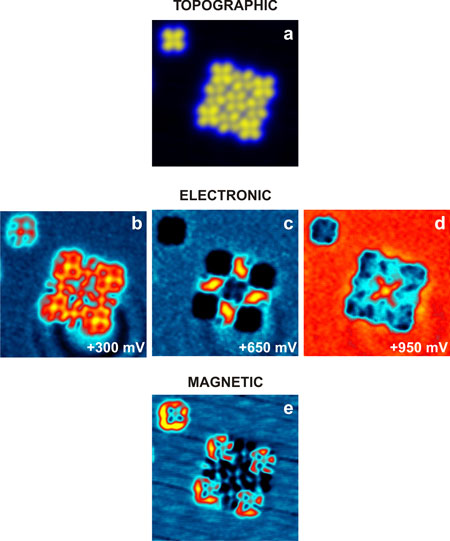| Oct 05, 2011 |
Molecular sudoku
|
|
(Nanowerk News) Sudoku puzzles represent a popular exercise recommended to improve logical and creative thinking. A team of scientists from the Catalan Institute of Nanotechnology, ICREA, and Universitat Autonoma de Barcelona investigated the properties of a special kind of sudoku, made by assembling tiny molecules into a 3x3 square array (see figure).
|
|
The result is not a mind-boggling game, but a detailed picture of how each molecule interacts with its neighbors and conducts electricity when squeezed between two metallic electrodes.
|
|
As reported this week in Nature Communications ("Spin coupling and relaxation inside molecule–metal contacts"), the researchers used the atomically-sharp tip of a scanning tunneling microscope to move 1-nanometer sized molecules on top of a silver substrate. The tip is controlled with such great accuracy that it is possible to precisely choose the position of each molecule and build tiny molecular squares, crosses, and chains of controlled size and orientation. The same tip is then used as a mobile electrode to probe the electrical conductivity of the molecules as a function of their position in the array.
|
 |
| Topography of a "sudoku" molecular cluster.
|
|
Figures a-d show an example of such measurements: a represent the topography of a "sudoku" molecular cluster, whereas b-d show regions of high conductivity at different voltages. At low voltage, electrons prefer to pass through the corner molecules, whereas at high voltage, only the central molecule is conducting. This is so because the conductivity depends strongly on a small set of electronic states, which conduct electricity to t he substrate, and these are modified by the presence of side-to-side neighbors.
|
|
The molecular conductance was found to vary strongly not only from one molecule to another, but also within each molecule, due to the possibility of exploiting different electron transport channels at different positions. Such conduction channels arise from the excitation of internal degrees of freedom of the molecules, such as atomic vibrations and magnetic coupling of the electronic spins.
|
|
All together, these results demonstrate the intricacy and beauty of molecular electronics, providing a glimpse of its advantages, such as the fabrication of versatile miniaturized circuits, and challenges, which may prove harder to solve than a sudoku game.
|

